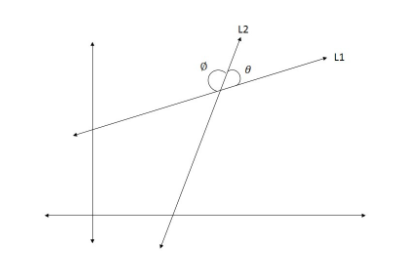
The angle between the lines y – x + 5 = 0 and $\sqrt {3x} - y + 7 = 0$ is/are
A.15°
B.60°
C.165°
D.75°
Answer
577.5k+ views
Hint: The angle between two lines is the angle between direction vectors of the lines. The angle between lines is given by $ = \tan \theta \left| {\dfrac{{{m_1} - {m_2}}}{{1 + {m_1}{m_2}}}} \right|$ where $m_1$ and $m_2$ are the slope of lines.
Complete step-by-step answer:
Let the line be
y - x + 5=0 ––––––––– (1)
$\sqrt {3x} - y + 7 = 0$ ––––––– (2)
We know that angle between 2 line can be found by using formula
$\tan \theta = \left| {\dfrac{{{m_1} - {m_2}}}{{1 + {m_2}m1}}} \right|$
Let the slope of line (1) be $m_1$ & slope of line (2) be $m_2$
Calculating $m_1$
From (1)
y – x + 5 = 0
y = x – 5
The above equation is of the form y = mx + c
Where m is the slope
Thus, $m_1$ = 1
Calculating $m_2$
From (2)
$\sqrt 3 x - y + 7 = 0$
$y = \sqrt 3 x + 7$
The above equation is of the form y = mx + c
Where m is the slope
Thus, ${m_2} = \sqrt 3 $
Angle between two lines is given
$\tan \theta = \left| {\dfrac{{{m_1} - {m_2}}}{{1 + {m_2}{m_1}}}} \right|$
Putting values
$\tan \theta = \left| {\dfrac{{1 - \sqrt 3 }}{{1 + \sqrt 3 }}} \right|$
$ = \dfrac{{1 - \sqrt 3 }}{{1 + \sqrt 3 }} \times \dfrac{{1 - \sqrt 3 }}{{1 - \sqrt 3 }}$
$ = \dfrac{{{{\left( {1 - \sqrt 3 } \right)}^2}}}{{1 - 3}}$
$ = \dfrac{{1 + 3 - 2\sqrt 3 }}{{ - 2}}$
$ = \dfrac{{2\left( {2 - \sqrt 3 } \right)}}{{ - 2}}$
$Q = {\tan ^{ - 1}}\left( {2 - \sqrt 3 } \right)$
Q = 15°
Thus, the acute angle between the lines (1) & (2) is θ = 15°
& obtuse angle between these two lines is
φ=180 – θ
= 180° – 15°
= 165°
So, from the above option both A and C options are correct.
Note: There are always two angles between the lines, one acute angle θ & other obtuse angle φ which are in linear pair,
Thus θ + φ = 180°
φ = 180° – θ

Complete step-by-step answer:
Let the line be
y - x + 5=0 ––––––––– (1)
$\sqrt {3x} - y + 7 = 0$ ––––––– (2)
We know that angle between 2 line can be found by using formula
$\tan \theta = \left| {\dfrac{{{m_1} - {m_2}}}{{1 + {m_2}m1}}} \right|$
Let the slope of line (1) be $m_1$ & slope of line (2) be $m_2$
Calculating $m_1$
From (1)
y – x + 5 = 0
y = x – 5
The above equation is of the form y = mx + c
Where m is the slope
Thus, $m_1$ = 1
Calculating $m_2$
From (2)
$\sqrt 3 x - y + 7 = 0$
$y = \sqrt 3 x + 7$
The above equation is of the form y = mx + c
Where m is the slope
Thus, ${m_2} = \sqrt 3 $
Angle between two lines is given
$\tan \theta = \left| {\dfrac{{{m_1} - {m_2}}}{{1 + {m_2}{m_1}}}} \right|$
Putting values
$\tan \theta = \left| {\dfrac{{1 - \sqrt 3 }}{{1 + \sqrt 3 }}} \right|$
$ = \dfrac{{1 - \sqrt 3 }}{{1 + \sqrt 3 }} \times \dfrac{{1 - \sqrt 3 }}{{1 - \sqrt 3 }}$
$ = \dfrac{{{{\left( {1 - \sqrt 3 } \right)}^2}}}{{1 - 3}}$
$ = \dfrac{{1 + 3 - 2\sqrt 3 }}{{ - 2}}$
$ = \dfrac{{2\left( {2 - \sqrt 3 } \right)}}{{ - 2}}$
$Q = {\tan ^{ - 1}}\left( {2 - \sqrt 3 } \right)$
Q = 15°
Thus, the acute angle between the lines (1) & (2) is θ = 15°
& obtuse angle between these two lines is
φ=180 – θ
= 180° – 15°
= 165°
So, from the above option both A and C options are correct.
Note: There are always two angles between the lines, one acute angle θ & other obtuse angle φ which are in linear pair,
Thus θ + φ = 180°
φ = 180° – θ

Recently Updated Pages
Why are manures considered better than fertilizers class 11 biology CBSE

Find the coordinates of the midpoint of the line segment class 11 maths CBSE

Distinguish between static friction limiting friction class 11 physics CBSE

The Chairman of the constituent Assembly was A Jawaharlal class 11 social science CBSE

The first National Commission on Labour NCL submitted class 11 social science CBSE

Number of all subshell of n + l 7 is A 4 B 5 C 6 D class 11 chemistry CBSE

Trending doubts
What is meant by exothermic and endothermic reactions class 11 chemistry CBSE

10 examples of friction in our daily life

One Metric ton is equal to kg A 10000 B 1000 C 100 class 11 physics CBSE

1 Quintal is equal to a 110 kg b 10 kg c 100kg d 1000 class 11 physics CBSE

Difference Between Prokaryotic Cells and Eukaryotic Cells

What are Quantum numbers Explain the quantum number class 11 chemistry CBSE




